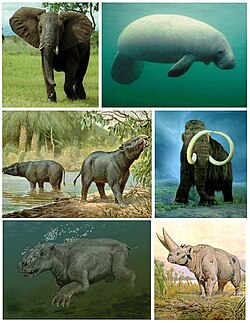| Tethytheria | |
|---|---|
 | |
| Top: African elephant, Caribbean manatee; middle: Moeritherium , woolly mammoth; bottom: Paleoparadoxia , Arsinoitherium | |
| Scientific classification | |
| Kingdom: | Animalia |
| Phylum: | Chordata |
| Class: | Mammalia |
| Grandorder: | Paenungulata |
| Mirorder: | Tethytheria McKenna 1975 |
| Subclades and orders | |
| |
 | |
Tethytheria is a clade of paenungulate mammals that includes the sirenians, proboscideans, and the extinct order Embrithopoda. [1]
Contents
Though there is strong anatomical and molecular support for the monophyly of Tethytheria, the interrelationships between the included taxa remain disputed. The tethytheres are united by several characters, including anteriorly facing orbits and more or less bilophodont cheek teeth (double transverse ridges on the crowns of the teeth). Proboscidea and Sirenia are linked together based on auditory characters in their petrosal bones, but this link may be a homoplasy. Desmostylians, traditionally considered tethytheres, have been tentatively assigned to Perissodactyla, along with the Early Eocene family Anthracobunidae, which was considered a sister group to Tethytheria. [2] [3]

